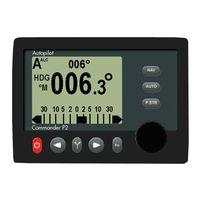ComNav Commander P2VS Manuals
Manuals and User Guides for ComNav Commander P2VS. We have 1 ComNav Commander P2VS manual available for free PDF download: Installation & Operation Manual
ComNav Commander P2VS Installation & Operation Manual (224 pages)
Advanced Autopilot Systems
Brand: ComNav
|
Category: Marine Equipment
|
Size: 11 MB
Table of Contents
-
Welcome3
-
-
Control Head29
-
Compasses31
-
Installation48
-
-
Power Supply48
-
Fasteners48
-
Control Head49
-
Compasses50
-
-
-
Power Supply64
-
-
Control Head66
-
Compasses68
-
-
-
Setting up88
-
-
Vessel Type92
-
Drive Setup93
-
-
45° Compass102
-
Magnetic Sensor104
-
-
Sea Trials105
-
Basic Operations112
-
STANDBY Mode118
-
Standby Menu119
-
Compass Source119
-
Default Turn119
-
Station Lock119
-
Backlight Level120
-
Battery122
-
Fishzag Time122
-
Watch Alarm122
-
-
POWER STEER Mode123
-
AUTO Mode125
-
Auto Menu126
-
Rudder Gain126
-
Counter Rudder127
-
Parameter Set128
-
Seastate128
-
Turn Rate128
-
Speed Source129
-
Thruster Assist129
-
Thruster Gain129
-
Helm Delay130
-
NAV Mode131
-
-
Nav Menu140
-
Dodge Turns142
-
-
Cautions145
-
-
-
WORK Mode151
-
WIND Mode154
-
Low Wind Speeds155
-
WIND-Points Mode156
-
Tacking159
-
Gybing161
-
Wind Menu163
-
Wind Source163
-
Wind Shift Delay164
-
Special Turns165
-
U-Turn166
-
Circle Turn167
-
Fishzag169
-
-
-
-
Periodic Checks179
-
Fuse Replacement180
-
PC COM Ports183
-
DB25 Connection184
-
DE9 Connection184
-
-
-
Heading & Status190
-
Heading Output190
-
Status Output191
-
-
Critical Errors197
-
Severe Errors198
-
Warnings199
-
Diagnostic Leds203
-
Index215
-
Settings & Notes221
Advertisement
